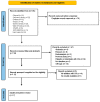Effects of Whole-Body Vibration Exercise on Athletes with Ankle Instability: A Systematic Review
- PMID: 36901543
- PMCID: PMC10001805
- DOI: 10.3390/ijerph20054522
Effects of Whole-Body Vibration Exercise on Athletes with Ankle Instability: A Systematic Review
Abstract
Objective: Chronic Ankle Instability (CAI) or Functional Ankle Instability (FAI) is a condition characterized by laxity and mechanical instability in the ankle joint. This instability interferes with the activities and physical-functional parameters of athletes, which leads to repetitive ankle sprains. The current systematic review was carried out to identify the effects of whole-body vibration exercise (WBVE) in athletes with CAI.
Methods: We conducted electronic searches in Pubmed, the Cochrane Library, Embase, Web of Science, Scopus, Science Direct, Allied Health Literature (CINAHL) and Academic Search Premier (ASP) (EBSCO) databases on 26 February 2022. Registers were identified, and studies were selected for inclusion according to the eligibility criteria. The methodological quality was assessed by the Physiotherapy Evidence Database (PEDro) scale.
Results: Seven studies were included with a mean methodological quality score of 5.85, considered 'regular' quality on the PEDro scale. WBVE interventions in athletes with CAI showed that this exercise contributes to a better response on parameters of neuromuscular performance, muscle strength and consequently in balance and postural control, variables that are for the management of CAI.
Conclusion: WBVE interventions in sports modalities promote physiological responses that may lead to positive effects in several parameters. The protocols proposed in each modality can be carried out in practice and are considered effective additional exercise and training methods beyond traditional types of training for athletes. However, more studies are needed on athletes with this condition, with specific protocols, to highlight the possible physiological and physical-functional responses. Protocol study registration: PROSPERO (CRD42020204434).
Keywords: ankle rehabilitation; athletes; chronic ankle instability; mechanical vibration; vibrating platform.
Conflict of interest statement
The authors declare no conflict of interest.
Figures



References
-
- Jaber H., Lohman E., Daher N., Bains G., Nagaraj A., Mayekar P., Shanbhag M., Alameri M. Neuromuscular control of ankle and hip during performance of the star excursion balance test in subjects with and without chronic ankle instability. PLoS ONE. 2018;13:e0201479. doi: 10.1371/journal.pone.0201479. - DOI - PMC - PubMed
-
- Gribble P.A., Bleakley C.M., Caulfield B.M., Docherty C.L., Fourchet F., Fong D.T., Hertel J., Hiller C.E., Kaminski T.W., McKeon P.O., et al. Evidence review for the 2016 International Ankle Consortium consensus statement on the prevalence, impact and long-term consequences of lateral ankle sprains. Br. J. Sport. Med. 2016;50:1496–1505. doi: 10.1136/bjsports-2016-096189. - DOI - PubMed
Publication types
MeSH terms
LinkOut - more resources
Full Text Sources

